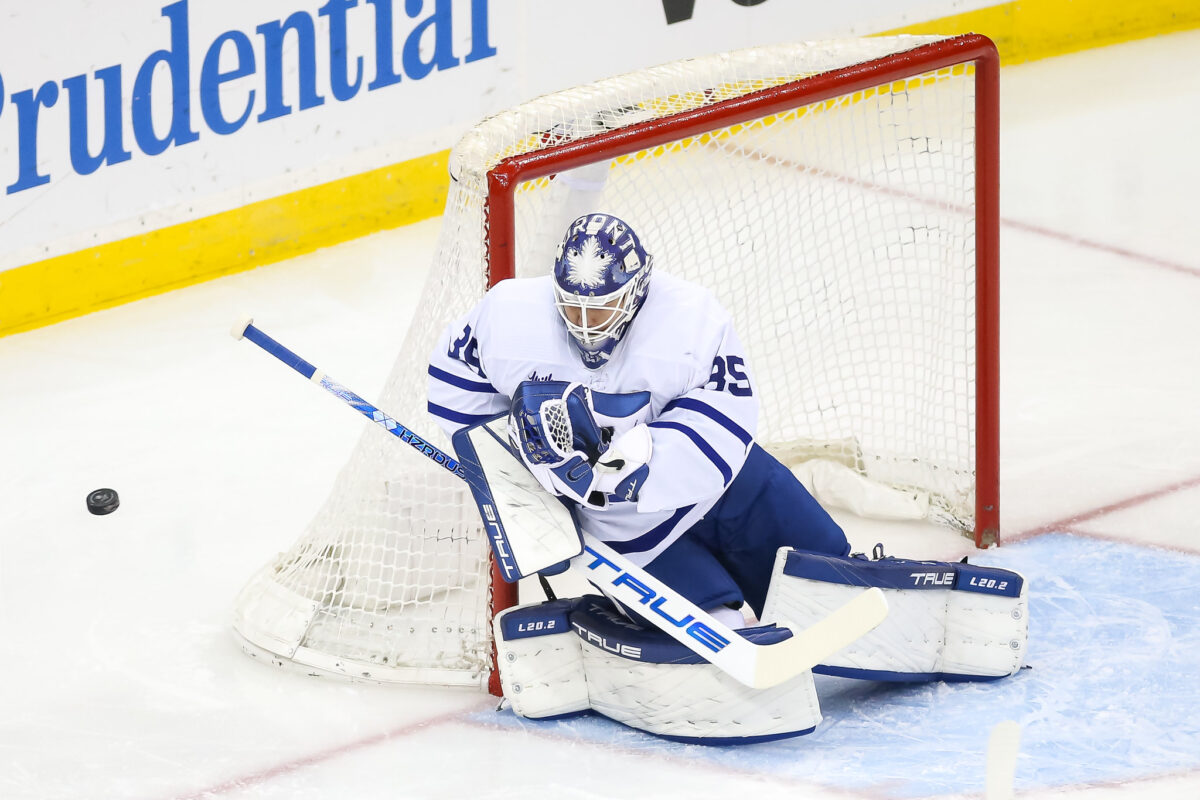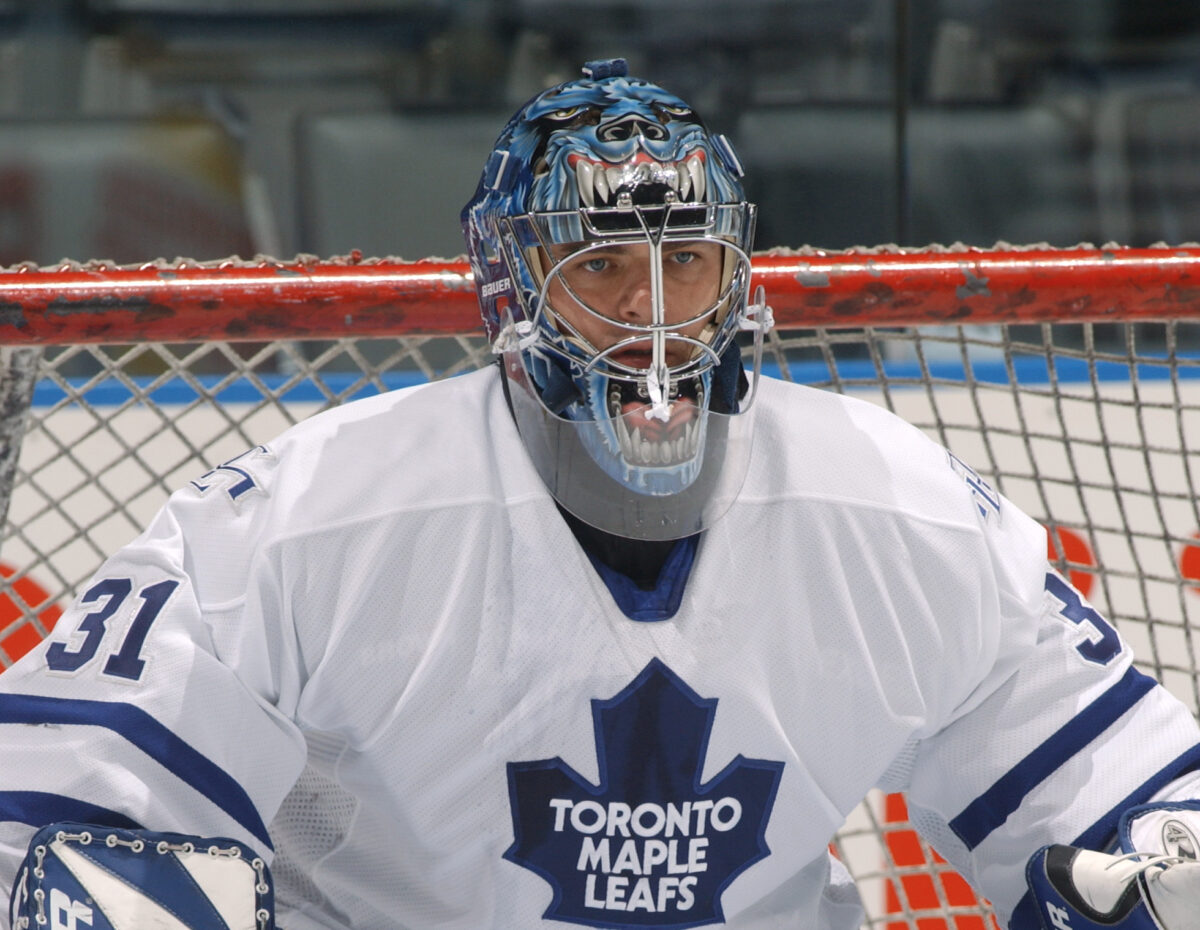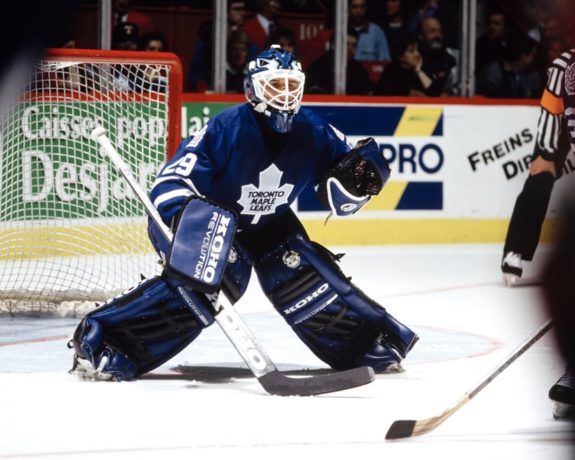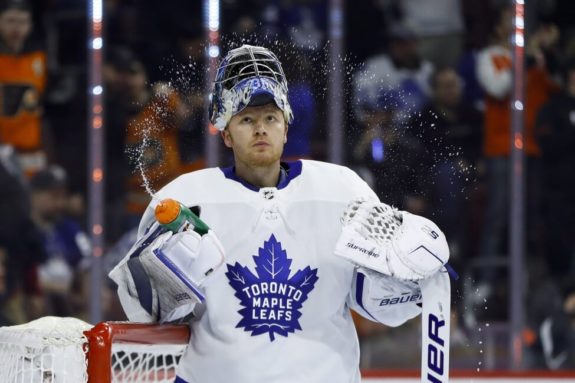I’ve enjoyed the past five years as I’ve covered the Toronto Maple Leafs. As many readers know, I come to writing about hockey from my history of being a teacher, a professor, and a researcher. I continue to do those jobs and bring that background to my work here.
Only in the past five seasons since I began to cover the Maple Leafs for The Hockey Writers have I started to marry my academic background and my interest in hockey. This is a research post, where I used a simple research methodology to answer the following question: “Since 1990, who has been the best Maple Leafs’ goalie?”
What Generated My Hockey Research Question
I’m specifically interested in the position of goalie. It seems that NHL goalies are a unique breed with quirks (probably necessary ones) that allow the good ones to thrive at their jobs.
Related: Talking Toronto Maple Leafs goalies with The Goalie Guild
For example, in the Maple Leafs’ game against the Ottawa Senators on March 18, 2023, the result of the game didn’t come after regulation or even after the overtime period. Instead, the winner was decided after a nine-round shootout where 18 different players came down alone on both of the goalies. After the game, I listened to an interview with Maple Leafs’ goalie Matt Murray who made what I thought was a remarkable revelation.
When his teammates were shooting on Senators’ goalie Mads Sogaard, he didn’t watch. He buried his head in his hands and just listened to the crowd. I would have had to watch, I believe. But then, he’s the goalie, and I’m not.
Thinking about that interview also made me consider the squeezing pressure goalies must be under during shootouts. It’s not just that one mistake could lose the game; it’s that one mistake WILL lose the game.
Now to the Question: Who Have Been the Maple Leafs Best Goalies?
My interest in goalies – how they play, what they think, and what makes them good – led me to ask this question. What makes a good NHL goalie? I thought that, if I could generate a list of characteristics that good NHL goalies possessed, I could then apply these characteristics to Maple Leafs’ goalies throughout history.
Related: Ex-Maple Leafs Goalie Michael Hutchinson: Where’s He Now?
The task I chose was to review Maple Leafs’ goalies by applying the criteria I found and then try to assess who was the best Maple Leafs’ goalie. For three reasons, (1) to make the study manageable (the Maple Leafs have been around for more than 100 years, and there were a lot of goalies), (2) because I think hockey has changed greatly over the years from the early days to the present, and (3) because I know more about recent hockey than hockey of the more distant past, I chose 1990 as the year to begin to study Maple Leafs’ goalies.
What Makes NHL Goalies Good Goalies?
I began with the question: “What are the characteristics of a good NHL goalie?” Here’s what I found.
Characteristic 1: Can a Goalie Stop the Puck?
First, the most fundamental characteristic of good NHL goalies is their ability to stop the puck. Good goalies need good reflexes and quick reaction times. They also must be able to track the puck and anticipate where it’s going to go.
Former Maple Leafs’ coach Mike Babcock used to say that Ron Hainsey was a good defenseman because he knew where to stand. That seems simple, but good goalies need to know how to position themselves well. From that position, they need to be able to read the play in front of them. If they can’t, they won’t be able to make saves.
Characteristic 2: Does a Goalie Have Mental Toughness?
Another important characteristic of good NHL goalies is their mental toughness. As noted earlier when speaking about Murray’s recent shootout experience, being a goalie is to perform regularly in high-pressure situations. Good goalies must stay calm and focused under pressure.

The best goalies also must be able to handle setbacks (including their own mistakes) and accidents that they can’t control (when Jake McCabe – for example – tries to block a pass but knocks it through Ilya Samsonov’s pads into the net). When these regular things happen, good goalies must bounce back quickly from mistakes, dumb luck, or bad games.
Characteristic 3: Does a Goalie Have Good Physical Attributes?
Third, a goalie must have the necessary physical attributes to be successful. Size helps because taller goalies can cover more of the net. That said, smaller goalies can make up for a lack of size with quickness and agility.
Characteristic 4: Can a Goalie Communicate on the Ice?
Fourth, good goalies need good communication skills. Goalies must communicate well with their defensemen (mostly) and provide clear instructions about where they want them to be on the ice.
Obviously, a variety of other factors contribute to a goalie’s success, but the four above are important characteristics.
Given These Criteria, Who Are the Best Maple Leafs’ Goalies Since 1990?
Based upon these criteria, who have been the best Maple Leafs’ goalies since 1990? My research suggests that the Maple Leafs suited up a number of talented goalies since 1990. Again to make the length of the post manageable, I have limited the number of goalies I’m looking at to four. Some great goalies, like Grant Fuhr, played for the Blue & White, but did not have solid seasons with Toronto.
Related: Maple Leafs’ Goalie Tandem Is Biggest Risk of Kyle Dubas’ Tenure
From the list of good NHL goalies who have played for the Maple Leafs since 1990, I believe the following four goalies are the best according to the four criteria I listed earlier.
Curtis Joseph
Curtis Joseph (or “Cujo”) played for the Maple Leafs from 1998 to 2002. During his four seasons with the Maple Leafs, Joseph played in a total of 249 games, with a record of 133-88-34 ties. He had 17 shutouts.
In those four seasons, his goals-against-average ranged from 2.23 to 2.56, and his save percentage ranged from .906 to .915. Although there were variations in his performance from season to season, Joseph’s record with the Maple Leafs was consistently strong, with a save percentage above .900 and a GAA below 2.60 in each season.

Cujo was renowned for his acrobatic saves and quick reflexes. His winning record during his time with the team helped them make the playoffs in all four seasons.
Felix Potvin
Felix Potvin was known as “The Cat.” Potvin played for the Maple Leafs for eight seasons. During his time with the team, he played 369 games and put up a record of 160-149-49. He had 15 shutouts. His goals-against-average ranged from 2.29 to 3.81, and his save percentage ranged from .866 to .910.
Related: Maple Leafs Fans Continuing Love Affair with Felix Potvin
Potvin was known for his athleticism and quick glove hand. He helped lead the Maple Leafs to the Western Conference Final in 1993 and was named to the NHL All-Rookie Team that season.
Ed Belfour
Ed Belfour’s nickname was “Eddie the Eagle.” Belfour played for the Toronto Maple Leafs for three seasons between 2002 and 2006. During his time with the team, he played 170 games and put together a record of 93-51-22 with 11 shutouts. His goals-against-average ranged from 2.13 to 3.29, and his save percentage ranged from .892 to .922.
Belfour was known for his strong positional play and mental toughness. He helped lead the Maple Leafs to the Eastern Conference Final in 2002-03 and was second to Martin Brodeur in the Vezina Trophy voting in 2003-04.
Frederik Andersen
Frederik Andersen was simply known as “Freddy.” He played with the Maple Leafs for five seasons from 2016 to 2021. During his tenure, he played 268 games, with a record of 114-38-23 (overtime losses). He had eight shutouts. His combined save percentage was 0.916, with a goals-against average of 2.67.
Related: Frederik Andersen’s Unforgivable Sin According To Maple Leafs Fans
Andersen’s best season with the Maple Leafs was in 2017-18 when he set the franchise record of 38 wins in his 66 games. He was a big goalie who was able to make big saves at key moments. He helped lead the Maple Leafs to the playoffs in each of his first three seasons with the team.
Assessing These 4 Goalies in Stopping the Puck
Which of these goalies stopped the puck the best? Although this is a statistically specific category, it still can be hard to rank these goalies with certainty. Each played during a different hockey era or played with teams that offered varying levels of support. However, based solely on save percentage as a measure of the percentage of shots a goalie stops, here’s a ranking of these goalies from highest to lowest save percentage during their time with the Maple Leafs.
- Frederik Andersen: .916 save percentage
- Ed Belfour: .909 save percentage
- Curtis Joseph: .908 save percentage
- Felix Potvin: .904 save percentage
Assessing These 4 Goalies’ Mental Toughness
The concept of mental toughness is subjective. It’s difficult to measure because it isn’t tied to statistical analyses in the same way save percentage or goals-against-average is. However, based on their reputations about their performance under pressure, here’s my subjective ranking of these goalies in terms of mental toughness.
- Ed Belfour: Belfour was known for his intense mental focus. This helped him perform well in big games and under pressure. He also had a reputation for being fiercely competitive and driven to win. He was meticulous in his preparation and structured a routine to ensure he was mentally and physically ready to play.
- Curtis Joseph: Joseph was also known for his ability to perform well in pressure situations. He had a calm and composed demeanor on the ice, which allowed him to bounce back quickly from bad goals or games.
- Frederik Andersen: Andersen was able to stay calm and composed under pressure. Often teammates praised his mental toughness and leadership. He was also known for being a strong communicator on the ice.
- Felix Potvin: Potvin was best known for his athleticism and acrobatic saves. However, he was also prone to get rattled by bad goals or bad games. However, he did show mental toughness during the team’s playoff run in 1993.
Assessing These 4 Goalies’ Physical Attributes
Ranking goalies based on physical attributes is also subjective and can vary depending on the specific attributes being considered. However, based on the commonly understood physical attributes for goalies (size, quickness, and athleticism), here’s my subjective ranking of these four goalies:
Related: Maple Leafs’ Prospect Hildeby Rising Among Swedish Goalies
- Frederik Andersen: Andersen had size. He was 6-foot-4, which gave him a huge advantage covering the net. He was also known for his quickness and ability to make tough saves look easy.
- Felix Potvin: Potvin was known for his athleticism and quick reflexes. He made acrobatic saves to keep his team in games. Despite being one of the smaller goalies on this list at 6 feet, he was quick and agile for his size.
- Curtis Joseph: Joseph was also not a large goalie. However, he had quick reflexes and the ability to move quickly from post to post. His strong lateral movements helped him make tough saves.
- Ed Belfour: Belfour was also not a bigger goalie. Nor was he known for his quickness or athleticism. However, he made up for deficiencies with positioning and mental toughness. He anticipated shots and made timely saves.
Assessing These 4 Goalies’ Communication Skills
For the third category of the four, ranking goalies on their communication skills is subjective and hard to measure. However, based on their reputations of how they were perceived by teammates and coaches, here’s my subjective ranking of the four goalies’ communication skills:

(Photo by Denis Brodeur/NHLI via Getty Images)
- Frederik Andersen: Andersen was known to be a strong on-ice communicator. His teammates praised his ability to direct traffic and provide clear instructions during games. He was reputed to be a leader on and off the ice and was respected by his teammates.
- Curtis Joseph: Joseph was also known for his communication skills and ability to direct his teammates on the ice. He was calm and composed, and he communicated effectively even in high-pressure situations.
- Ed Belfour: Belfour was known to be vocal on the ice. He didn’t hesitate to call out teammates when needed. I also read that he was a mentor to young players and was respected for his knowledge of the game.
- Felix Potvin: Potvin was not known to be a great communicator. He was considered more of a lone wolf. Although he was known to be athletic and able to make difficult saves, he was not as vocal or communicative as the other goalies on this list.
So Who Was the Best Maple Leafs Goalie Since 1990?
Even considering the four criteria of save percentage, mental toughness, physical attributes, and communication skills, it’s still tough to say which goalie was the best for the Maple Leafs since 1990. Each goalie on this list had his own strengths and weaknesses, and their performances varied from season to season.
However, the one goalie who seemed to consistently perform at a high level was Andersen. He came out first on three of the four categories, and he was third in the fourth.

He had a strong save percentage during his time with the Maple Leafs. He was the most physically gifted of the Maple Leafs’ goalies. Although he sometimes let in some softies at the worst possible times, he is also known for his mental toughness and his ability to perform in high-stress situations. He was a strong communicator on the ice.
Of course, this is my subjective assessment. Others might argue differently. But, based on the research that I have done, I believe the best Maple Leafs’ goalie since 1990 was Andersen.
